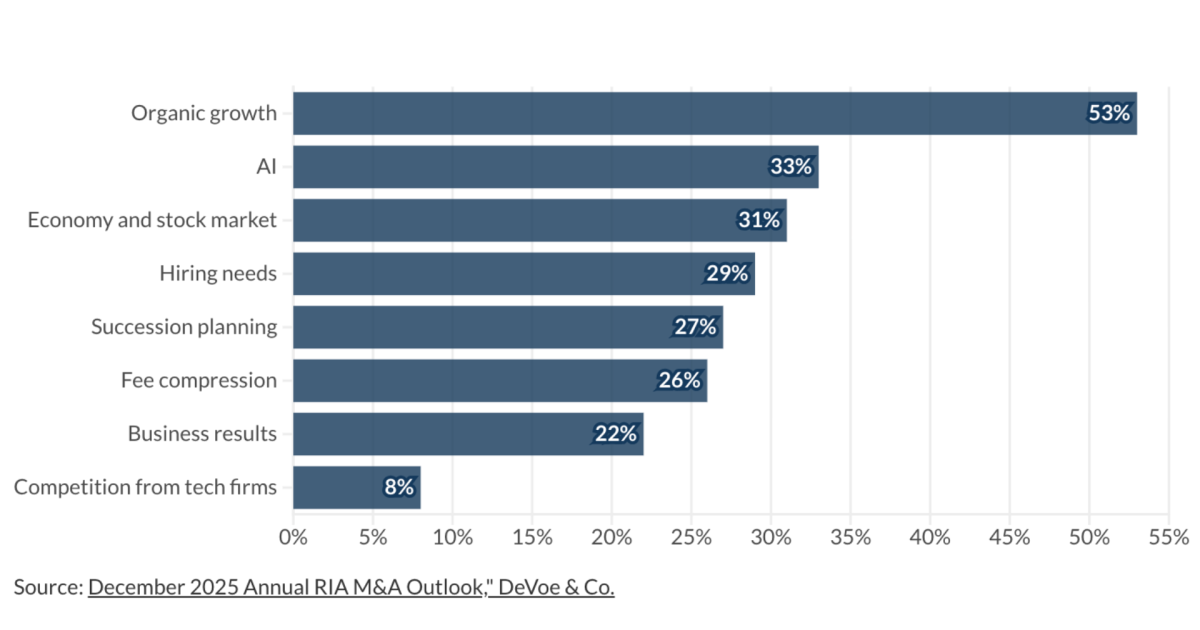With the U.S. stock market in the midst of a three-year bull run, many investors no doubt are looking back at their equities gains and wondering why they should put money into anything else.
But such a fixation on the recent past could be a breeding ground for complacency, warn various investment and wealth managers. In particular, it could blind investors to the gains that could be had from private equity, private credit and other alternative markets for investors with spare cash and the stomach for a little risk.
Matt Kosterman
Brian Griggs, the head of portfolio strategy and solutions at the investment management firm Nuveen, agreed that many investors are no doubt feeling pretty comfortable with the returns they’ve secured from public markets in recent years.
“Recency bias is still very much a thing,” Griggs said. “So if you don’t have that pressure where clients are asking you — ‘Well, why hasn’t my portfolio done better?’ — it makes it a higher hurdle to kind of get yourself educated and better equipped to allocate to private markets.”

Doug Huber, deputy chief investment officer at the large RIA Wealth Enhancement Group, has detected signs that investors are growing curious about going beyond standard stocks and bonds.
“I do believe the majority is certainly in the camp of, ‘Hey, this is working. This is great. How could you possibly beat this?,” Huber said. “But I would also add that there is definitely a subset of clients that are taking the other side of that trade, whether they are thinking about it in the full context, or just saying, ‘Hey, I’ve got enough of this. Give me something else.'”
Private markets are huge, but clients don’t talk about them much
Yet, despite all this interest, clients are also still rarely broaching alternative investments in financial planning discussions. A recent survey of 1,000 high net worth investors with $1 million or more by Goldman Sachs and the research firm 8 Acre Perspective found that only 41% of the respondents had brought up the subject of private markets with their financial advisors. Much more likely to be discussed, according to the “Opening Doors to Alternatives” report, were exchange traded funds (60%) and ways to lower taxes on investments (69%).
Alternative investments have become one of the most debated investing topics in recent years. Within private markets, they’re most likely to consist of private equity (shares owned in non-listed companies), private credit (money lent outside the banking system) and private real estate (property owned through non-listed investment trusts).
Kyle Kniffen, Goldman Sachs global head of third-party wealth for alternatives and an author of the alternatives report, noted that survey results did show growing interest among different types of investors in putting money into a wide variety of private investments.
“We believe that reflects a role for alts in a wide range of individual investor portfolios, signaling further adoption,” he said.
Private markets is certainly growing. The consulting firm Bain & Co. found in 2022 that individual investors had already plowed $4 trillion into alts like private credit and real estate and predicted the figure could rise to $12 trillion in the next decade. President Donald Trump’s administration has also pushed for opening these markets. An executive order in August called on the Department of Labor to reconsider its guidelines barring many types of alternative investments from 401(k)s and other retirement plans.
Wealth managers are in a race to help regular investors explore this terra incognito of private markets. Advocates of private equity, credit and other alternatives hold promises of higher returns and increased diversification even as critics complain of high fees, obscure underlying fundamentals and barriers to pulling out investors’ money.
Big wealth managers’ role in helping advisors sift out risky private investments
Nuveen, WEG and Dynasty are among the firms positioning themselves as gatekeepers to these sometimes risky, but also often profitable, markets. Charles Schwab is also moving into a similar position with its announcement this week that it will buy the private shares marketplace Forge Global for $660 million. That followed closely on Morgan Stanley’s purchase of EquityZen, a firm that likewise helps investors buy shares of private companies.
“The number of eligible clients at Schwab today who are looking to diversify with alternatives and in private markets specifically is unmatched in the industry,” Schwab CEO Rick Wurster said in a call with investors about the Forge purchase. “Schwab will be the place for private market sellers to find interested buyers and vice versa across our retail and advisor services client segments.”
At Dynasty Financial Partners, chief investment officer Bob Shea said his firm’s service offerings include help for advisors sorting out good private investment opportunities from downright treacherous ones.

“I think if we’re doing one thing that’s pretty useful and powerful, and it’s for our average client household with $7 million, it’s taking the responsibility on our end to do the right due diligence, the right gatekeeping, the right sourcing,” Shea said.
The Goldman survey found that allocations to private markets do increase as clients move up the wealth scale. Just over 90% of respondents with $20 million or more say they have invested in private equity, credit, real estate and similar funds. In the $5 million-to-$10 million asset range, only 63% said they had. A fifth of all the respondents’ net worth remained in cash.
Net worth isn’t everything. Free cash matters, too
With their liquidity barriers, private markets are in many ways the most natural fit for the ultrawealthy. Griggs at Nuveen, though, said net worth isn’t the main consideration; more important is the amount of spare cash investors can afford to lock up for years in search of higher returns.
Using spending habits and free cash as a gauge, Griggs thinks far more investors could be moving beyond standard stocks and bonds. He said Nuveen will recommend as much as 20% to 30% of ultrahigh net worth investors’ portfolios be in private markets.
“But if you look at the data on the use of private markets, the average allocation is somewhere from 5% to 7%. I think that average allocation will grow over time,” Griggs said. “I would challenge advisors with the question that, if you do the financial planning, you’d probably find that most clients don’t need 100% of their portfolio in a daily liquid form.”
Goldman’s report found that investors with over $10 million in assets have about 15% of their portfolios allocated to alternatives. When the asset range is $1 million to $5 million, the share falls to 8%.
Shea sees an opportunity in those numbers.
“We deal in a big gray area, which is the $5 million to $10 million household that may feel like they’re not in a great spot without some help to evaluate good versus bad, risky versus not risky,” he said.
Millennials vs. boomers, and fewer publicly traded shares
The Goldman survey, conducted in July and August, also revealed a generational divide. Among millennials (often defined as being born between 1981 and 1996,) 1 of 5 have put money into alternatives and just over half said they perceive private markets as a way to invest in growth industries. Among baby boomers (born between 1946 and 1964,) the allocation to private markets fell to 6%.
Shea said he has noticed a distinct delineation in the more than 50 advisory firms Dynasty provides various types of support services to. Those with younger advisors and clients tend to be open to having relatively large allocations to private markets.
“And then you have your 55-year-old advisor and 65-year-old client that’s done just fine in public and perhaps doesn’t need the grief and just might not be there for the extra complication and sophistication of private markets,” Shea said.
One development often cited by advocates of private markers is the great drop in companies listing their shares publicly. The Securities and Exchange Commission noted in a recent report on opening private markets to retail investors that the number of publicly traded companies has plummeted between 1996 and 2004 from 8,000 to 3,700.
Meanwhile, some of the strongest growth firms — names like Elon Musk’s Space X and the AI giant Perplexity — remain private.
“I’ve never seen a bigger disconnect between the number of growth companies that are in the public markets versus private markets,” Shea said. “Companies just aren’t going public the way they were. And until that changes, if you want to get at the drivers of this economy for the next 10 years, you have to take some liquidity risk and get private market allocations on the income side.”
Huber of WEG said he thinks more advisors are starting to recognize some of the biggest growth opportunities are now in private markets.
“And to get exposure to the true meat of the economy, I do think privates are a potential solution for that,” he said.
If stocks slow, are private markets the best alternative?
Diversification is still one of the biggest reasons for getting into private markets. The Goldman survey found that many investors consider private equity, private credit and other alternatives “high risk” — a label deemed appropriate by 56% of the respondents.
The main counterbalance inventors wanted for those perils was diversification. Fifteen percent of the respondents cited portfolio diversity as their No. 1 goal for investing in alternatives, ahead of the 13% who said they were primarily seeking enhanced returns.
Griggs at Nuveen said private markets’ promise as a diversifier has become only sharper as questions hover over the stock market’s ability to maintain its recent gains. Arguments have become common that public shares are overvalued. Companies listed on the S&P 500 are now valued at about 40 times their inflation-adjusted average earnings over the past 10 years.
“So it’s hard to argue with the statement that valuations are elevated,” Griggs said. “And accordingly, you should expect lower returns going forward.”
Equities wouldn’t even have to go into bear territory to be a drag on clients’ portfolios. With inflation running near 3%, returns need only fall back from their recent highs before price increases start eating into the money investors have stowed away.
Griggs said again the temptation for many advisors and clients is to look back at recent equity returns and assume they can keep obtaining more of the same. He’s not so certain.
“I do worry that maybe too much of the industry is extrapolating our experience over the last 10 years and using that as kind of a guide to think through their portfolio construction going forward,” he said. “And I think that’s what we’re really trying to help advisors with is making sure they’re looking out the windshield and not too much of the rear view mirror when thinking about how to serve their clients for the macro environment ahead.”



























